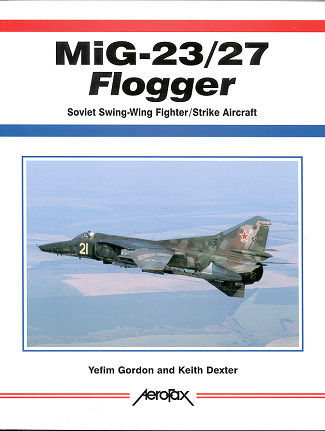 Continuing with
their superb books on Soviet and Russian aircraft, Aerofax has released this new
title on the MiG-23/27 'Flogger' series of aircraft.
Continuing with
their superb books on Soviet and Russian aircraft, Aerofax has released this new
title on the MiG-23/27 'Flogger' series of aircraft. |
Title: |
MiG-23/27 Flogger: Soviet swing wing fighter/strike aircraft |
|
Author: |
Yeflim Gordon and Keith Dexter |
|
Publisher |
Aerofax |
|
Price |
$36.95 from Specialty Press |
|
Reviewer: |
|
| Notes: | ISBN 1-85780-211-X |
 Continuing with
their superb books on Soviet and Russian aircraft, Aerofax has released this new
title on the MiG-23/27 'Flogger' series of aircraft.
Continuing with
their superb books on Soviet and Russian aircraft, Aerofax has released this new
title on the MiG-23/27 'Flogger' series of aircraft.
There was a time not too long ago when variable-geometry wings were the rage. In the US, European, and Soviet Union design teams, it was seen as a way to have low speed handling and high speed flight combined into one airframe. Probably the first successful production aircraft with this feature was the F-111, and it is admitted in the book that were it not from seeing how this aircraft was built, the MiG design bureau would never have attempted to emulate this wing style. As we are all aware, it spawned a number of successful designs such as the F-14, Tornado, and Su-17. It is also something that we have not seen since and most of these aircraft are either out of service or reaching the end of their useful lives.
The goal at MiG was to provide a replacement for the MiG-21 so the aircraft had to be faster and more capable than that which it was replacing. MiG designers could not put the landing gear in the wings so came up with a rather complex, but sturdy main gear arrangement that has worked quite well. The plane is able to operate from somewhat roughly prepared air fields if need be and still carry a useful war load.
The MiG-23 fighter was the initial design and since the Soviets generally get the plane out first and then allow operational units to help redefine the design, the MiG-23 was fraught with problems in its wing design and engine operation. The various bugs were worked out with these early types and the aircraft was transformed into a reliable and potent weapons system.
When it was time to look for a new ground attack fighter, the MiG OKB decided that using the MiG-23 airframe as a basis would be a good way to shorten development time and provide a proven airframe. The real change from the fighter to ground attack version was the removal of the large air intercept radar system and the redesign of the nose to allow better forward vision for the pilot. Several different versions of what was now the MiG-27 were developed, each with different sensor suites and capabilities. A simpler intake design was chosen for the MiG-27 as most of its mission time would be spent at lower altitudes. and it is the more simple intake splitter plate that is the main identity feature of the MiG-27. I say this because there was also a ground attack version of the MiG-23 developed that kept the larger and more complex intake design, combined with the sloped nose of the MiG-27.
As is the norm with Aerofax books, this one covers the full development of both types from original design conceptions through to operational use with both Soviet/Russian and foreign operators. A complete description of the different variants is provided as well as an operational history. There is a 'walk-around' section showing the salient features of the aircraft and this is enhanced by an excellent set of drawings and color profiles.
From what I understand, these aircraft have been withdrawn from service as the Russian Air Force now only wants twin engine aircraft for its tactical inventory, though they are still flying with some other countries.
Overall, another excellent book on Russian aviation from probably the world's authority on Soviet/Russian aircraft, and an excellent read to boot. Highly recommended.
January 2006
Review book courtesy of
![]() ,
where you can order your copy of this and many other superb aviation and
modeling books. Visit their website at the link above or call them at
1-800-895-4585
,
where you can order your copy of this and many other superb aviation and
modeling books. Visit their website at the link above or call them at
1-800-895-4585
If you would like your product reviewed fairly and quickly by a site that has over 300,000 visitors a month, please contact me or see other details in the Note to Contributors.